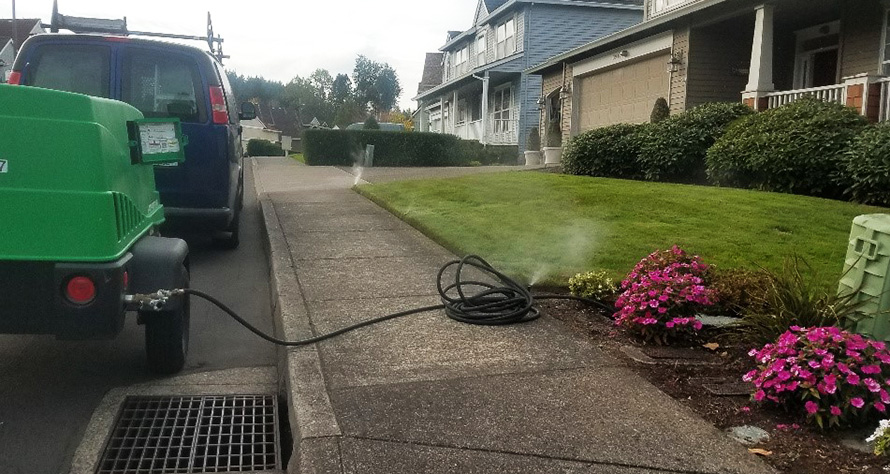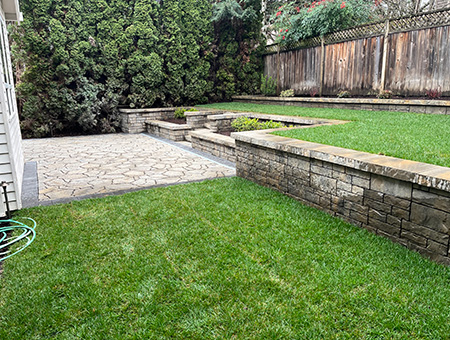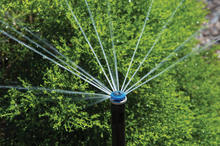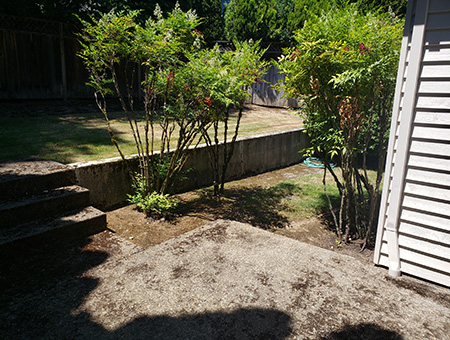
Sprinkler and irrigation systems can be extremely valuable when you need to water plants and crops over large spaces that would otherwise take hours to tackle with a basic hose and spray nozzle. However, in the Pacific Northwest, winter temperatures frequently drop below freezing, leaving those irrigation pipes and other components vulnerable to freeze damage. Expansion of residual water left in your system can lead to cracks and leaks in the system, including underground pipes, pumps, sprinkler heads, valves, and other parts.
To prevent this, Landscape East & West recommends irrigation winterization before the start of winter. Irrigation systems must be purged of all standing water within the pipes before the oncoming of freezing temperatures that come with winter this far away from the equator.
What is Irrigation Winterization?
 Winterizing an irrigation system, including sprinklers, valves, and more is a necessary process for protecting the structural integrity of your watering systems around the house. As winter temperatures often drop below freezing, the effect on the pipes and components is a situation where freezing water expands within the pipes forcing the pipes to expand beyond their capabilities resulting in splits and cracks.
Winterizing an irrigation system, including sprinklers, valves, and more is a necessary process for protecting the structural integrity of your watering systems around the house. As winter temperatures often drop below freezing, the effect on the pipes and components is a situation where freezing water expands within the pipes forcing the pipes to expand beyond their capabilities resulting in splits and cracks.
Additionally, sprinkler heads and valves made from the same material can also become loose or cease to function properly. Repairs for your irrigation system after cracking occurs involve the unearthing of pipes, finding leaks, and replacing parts that have become cracked and broken. It is far better to let Landscape East & West winterize your irrigation system each fall or early winter, rather than deal with the rising costs of repairing the damage.
What Temperatures Require Winterization, and When to Start?
Winterizing irrigation should begin before the first freeze, and after regular watering is needed to keep plants alive in the summer. The ideal time for winterization is mid-October into late November when temperatures in the Pacific Northwest are approaching freezing overnight. Frost on the ground in the mornings is usually not a problem as it will take a couple of days of temperatures at or below freezing to cause damage to your system.
How Landscape East & West Approaches Winterization
 Step one of irrigation winterization is to turn off the main shut-off valve with the valve key. If doing this yourself, slide the valve key down the pipe and line up the key over the valve handle. Turn the valve clockwise to shut the water off to the system. Step two is to open the drain valve. The drain valve is usually located next to the backflow device. Turn the valve key counter-clockwise and leave the valve open. This will allow the water to drain out. Cycle through all the zones on your controller, allowing each zone to open letting the water downstream from the irrigation valves flow back and out of the drain valve. A five-minute cycle per zone should do the trick. When all the water has drained out, close the drain valve. Now, turn your irrigation controller to the off position. If you’re unsure as to what kind of irrigation system you have, check with Landscape East and West and ask us to determine what winterization options will work best.
Step one of irrigation winterization is to turn off the main shut-off valve with the valve key. If doing this yourself, slide the valve key down the pipe and line up the key over the valve handle. Turn the valve clockwise to shut the water off to the system. Step two is to open the drain valve. The drain valve is usually located next to the backflow device. Turn the valve key counter-clockwise and leave the valve open. This will allow the water to drain out. Cycle through all the zones on your controller, allowing each zone to open letting the water downstream from the irrigation valves flow back and out of the drain valve. A five-minute cycle per zone should do the trick. When all the water has drained out, close the drain valve. Now, turn your irrigation controller to the off position. If you’re unsure as to what kind of irrigation system you have, check with Landscape East and West and ask us to determine what winterization options will work best.
The second option for winterizing an irrigation system involves a forced air blowout of all pipes. This is done by Landscape East & West because improperly delivered compressed air can cause serious damage to your system. However, we recommend air blowouts for several reasons. First, it forces all the water out of the mainline. Second, it also forces all the water out of the lateral lines and sprinkler heads. Plus, when we do this we guarantee against any freeze damage to your system.
Landscape East & West provides a full service for residential maintenance of watering systems. Premium Water Management Services (PWMS) is a stand-alone program designed for customers who are looking for dedicated irrigation system services and are not currently residential customers.
How Much Does Professional Irrigation Winterization Cost, and How Long Does It Take?
 Costs and time to perform a proper clear-out of your irrigation pipes and system will fully depend on the size of the system and the measures needed to protect it. If you decide to do it yourself, and we strongly discourage that, add the cost of renting a more powerful air compressor and air hose to your list of expenses. Professional contractors, including Landscape East & West, use commercial air compressors that deliver airflow amounts of 90 cfm to 180 cfm, allowing them to properly evacuate the water from the system.
Costs and time to perform a proper clear-out of your irrigation pipes and system will fully depend on the size of the system and the measures needed to protect it. If you decide to do it yourself, and we strongly discourage that, add the cost of renting a more powerful air compressor and air hose to your list of expenses. Professional contractors, including Landscape East & West, use commercial air compressors that deliver airflow amounts of 90 cfm to 180 cfm, allowing them to properly evacuate the water from the system.
The process of winterizing an irrigation system by air compression takes only a matter of minutes when done properly, but again, it will depend on the size of the system. While manual draining of the system relies on gravity and counts on your drain valve being the lowest point in your system, forced air winterizations blow the water completely out of your pipes through the heads and nozzles resulting in all water being removed regardless of elevations.
Get in Touch
Considering a landscaping project for your home or business? Contact us today to discuss your vision with one of our licensed professionals. We can provide realistic expectations and a timeline for your project to begin. We service the greater Portland, Oregon Metro area including Clackamas, Hillsboro, Lake Oswego, West Linn, and north into Clark county Washington. We would love to talk with you about applying our landscaping experience and expertise to your design and build!
